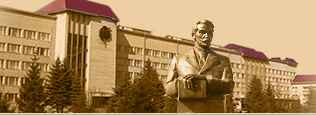CARTOGRAPHIC MODELING OF TRANSPORT FLOWS IN TERNOPIL
In this publication the research of transport flows in the Ternopil city of with the subsequent cartographic modeling is considered. This problem is well researched in the USA and EU countries, but it is only now being developed in Ukraine. The field research methods was used to collect information on the size of transport flows. This task was put to students in the form of an individual exercise in the selected streets of the city. The research of intensity of the transport flow according to certain stages and rules are performed. Each of the researchers the number of transport vehicles at the crossroads of one intersection per unit time counted. Analogical observations and calculations were throughout the chosen street of the city are conducted. Subsequently, all data into a calculated magnitude of traffic intensity on a certain street are converted, which reflected on a separate cartographic model. Mapping of transport streams of all the streets surveyed a general cartographic model in the city are formed. Three researches were conducted in autumns 2013, 2015, and 2017, and their results in three cartographic models are reflected. All source data to the creation of these models during the study of traffic flows on the streets of the city are collected. A brief geospatial analysis shows the highest values of the intensity of traffic on the byroad and the main city highways. In order to reflect the magnitude of the overload of the street network by streams of motor transport, a separate cartographic model was created. The ratio of actual traffic flows to normative is shows, which according to state standards in the construction of streets of the city are projected. The results of the comparative calculations showed that most of the streets in the city center with project norms are overloaded. Half of other city highways are close to the maximum traffic intensity according to normative indicators. The reasons for this are strong transport flows, insufficient bandwidth and low speed. According to the results of the research, the main problem factors (low street capacity, speed, parking problems and routes of public transport, increase in the number of cars) of the street network of the Ternopil city are formed. A separate point measures to reduce the intensity of transport flows and overload the streets of the city is promising. These include improving traffic management, improving and developing the street network, development of high-speed roads and improving the quality of urban public transport.
Key words: intensity, cartographic model, city, transport, transport flow.
References:
- Bespalov D. Modeliuvannia transportnoho potoku na peretynakh v riznykh rivniakh. URL: https://bespalov.me/2014/01/08/modelyuvannya-transportnogo-potoku-na-peretynah-v-riznyh-rivnyah/
- Buhromenko V. K. Transport v terrytoryalnыkh systemakh / V. K. Buhromenko ; Tykho-okean. yn-t heohrafyy. –– M. : Nauka, 1987. –– 110 s.
- DBN V.2.3-5-2001 «Vulytsi ta dorohy naselenykh punktiv». URL: https://netbaryerov.org.ua/bud_norm/1219871193.doc
- Lobanov E. M. Transportnaia planyrovka horodov : uchebnyk/ E. M. Lobanov. –– M. : Transport, 1990. –– 249 s.
- Mazur V. Improvement of City Traffic Network Based on an Analysis of its Features // Kompiuterni systemy proektuvannia. Teoriia i praktyka: [zb. nauk. pr.] / Visnyk / Natsionalnyi Universytet «Lvivska politekhnika»; Lviv: Vydavnytstvo NU «Lvivska politekhnika», 2014. – № 808 – S. 56-59.
- Osetrin M. M. Miski dorozhno-transportni sporudy : navchalnyi posibnyk / M. M. Osetrin. –– K. : In-t zmistu i metodiv navchannia, 1997. –– 194 s.
- Osnovy orhanizatsii dorozhnoho rukhu. URL: http://elib.lutsk-ntu.com.ua/book/mbf/auto/2010/10-139/page8.html
- Stavnychyi Yu. A. Transportnыe systemы horodov / Yu. A. Stavnychyi –– M. : Stroiyzdat, 1990. –– 219 s.
- Tarkhov S. A. Эvoliutsyonnaia morfolohyia transportnыkh setei : metodы analyza topolohycheskykh zakonomernostei / S. A. Tarkhov ; AN SSSR, Yn-t heohrafyy. –– M. : YH, 1989. –– 221 s.
